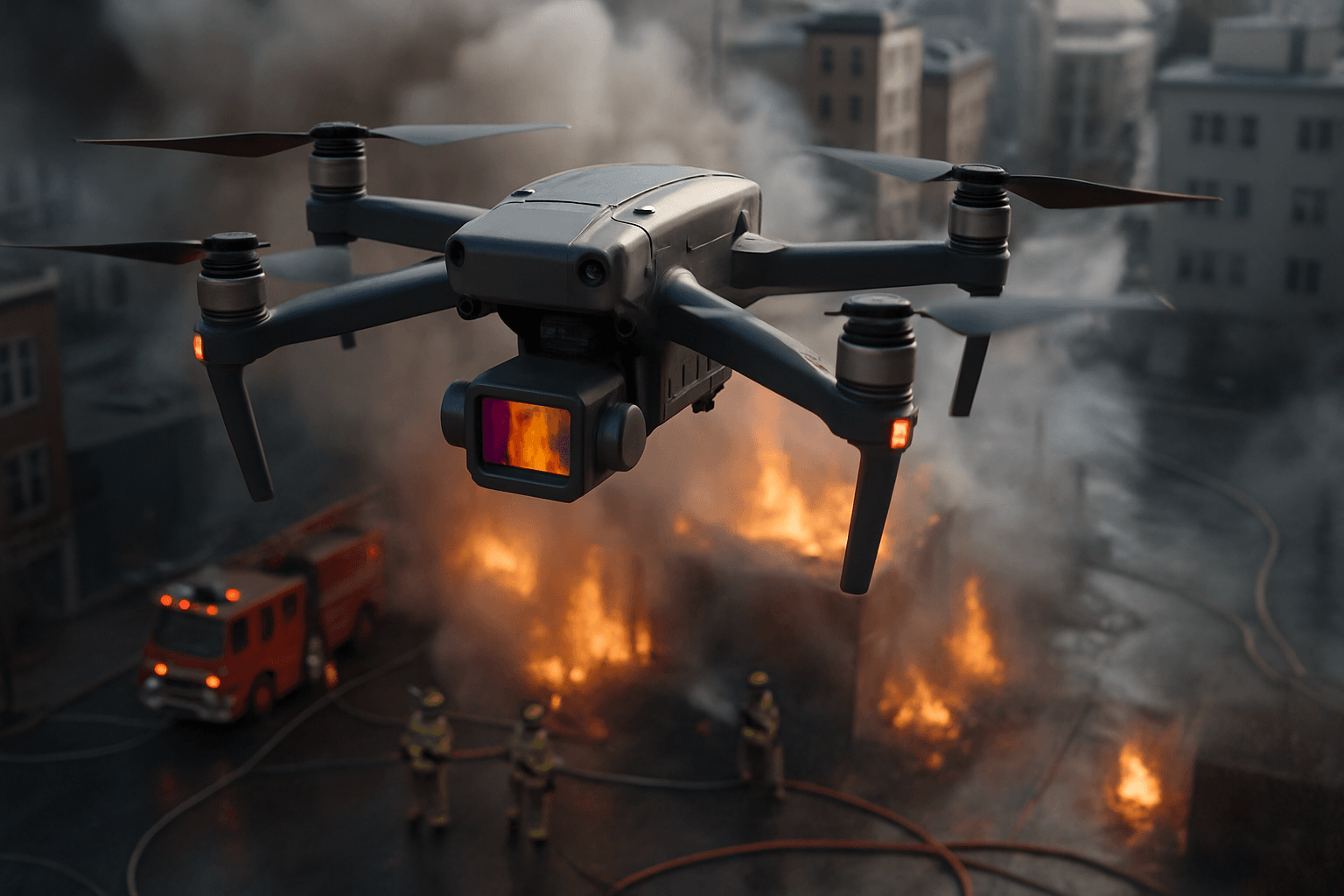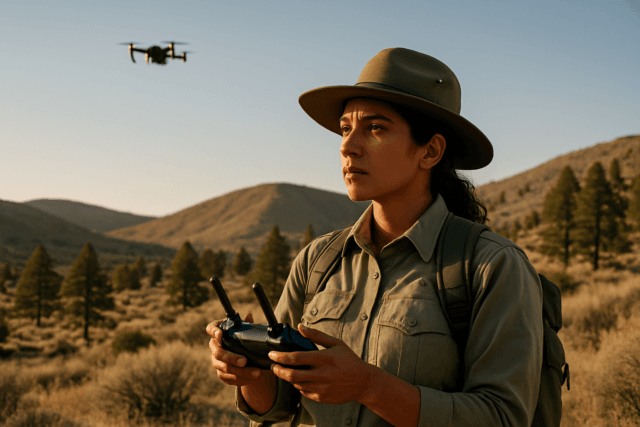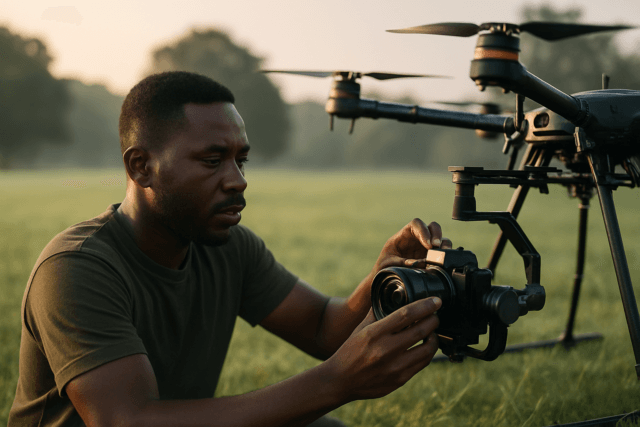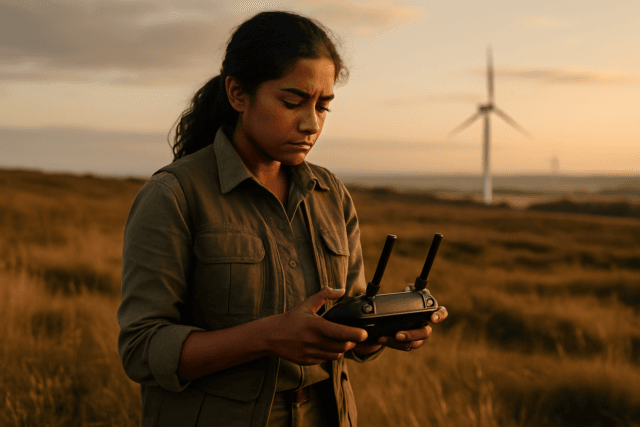Firefighting is an inherently dangerous and challenging profession, demanding quick decision-making and strategic resource allocation in high-stress environments. In recent years, technology has stepped up to provide invaluable assistance, and among the most promising advancements are drones. These unmanned aerial vehicles (UAVs) are rapidly transforming firefighting operations, offering enhanced situational awareness, improved safety, and increased efficiency. From real-time aerial surveillance to thermal imaging and search and rescue capabilities, drones are proving to be indispensable tools for modern fire departments.
What are Firefighting Drones?
A firefighting drone is any drone used by firefighters in their work. These specialized UAVs are equipped with a range of advanced technologies that enable them to support firefighting operations in diverse and challenging scenarios. They serve as first responders, providing aerial imagery before crews are dispatched, thereby minimizing risks to firefighters on the ground.
Key features of firefighting drones:
- High-resolution cameras: Capture real-time video and images, providing a clear aerial view of the fire scene.
- Thermal imaging cameras: Detect heat signatures and temperature variations, allowing firefighters to identify hotspots and locate trapped individuals, even in low visibility conditions.
- GPS and mapping capabilities: Enable precise navigation and mapping of the fire perimeter, aiding in resource allocation and evacuation planning.
- Communication systems: Relay critical information between firefighters in different locations, improving coordination and communication.
- Payload capacity: Some drones can carry additional equipment such as foam dispensers, water cannons, and searchlights.
How Drones are Used in Firefighting: Key Applications
Drones are used in firefighting in various ways to enhance operational efficiency and improve overall safety.
Here are some of the primary functions of drones in firefighting:
- Aerial Reconnaissance and Monitoring: Drones provide real-time aerial views of fire scenes to assess the situation and monitor fire spread. This allows incident commanders to make informed decisions on resource allocation, evacuation, and firefighting strategies.
- Thermal Imaging for Hotspot Detection: Drones equipped with thermal cameras can detect hotspots in burning structures or wildfires, allowing firefighters to target specific areas, prevent rekindling, and make safety assessments. These cameras pick up heat signatures invisible to the naked eye, allowing crews to identify dangerous areas, detect flare-ups before they spread, and ensure full extinguishment.
- Search and Rescue Operations: Drones can locate missing persons or trapped individuals in smoke-filled or otherwise inaccessible areas. Thermal cameras can detect heat signatures and provide valuable insights into the location of hotspots and potentially trapped individuals.
- Fire Scene Assessment: Drones document fire scenes and damage for investigations and insurance purposes. The DJI Matrice 4D, originally built for cinematic use, is now a precision tool for departments requiring clear imaging during fire investigations, structural documentation, or rapid scene assessment.
- Monitoring Hazardous Materials: Drones can be used to monitor hazardous materials, chemical leaks or gas emissions, guiding containment efforts.
- Wildfire Management: Drones monitor wildfire progression, map affected areas, and provide real-time data to support firefighting efforts and evacuation planning.
- Building Inspection and Damage Assessment: Drones can assess building integrity and structural damage, especially useful in hard-to-reach locations or when visibility on the ground is compromised.
- Flood Monitoring and Response: Drones can be used in flood monitoring and response, providing valuable insights during natural disasters.
- Delivering Emergency Supplies: Drones can deliver emergency supplies to firefighters or victims in need.
- Training and Simulation: Drones can be used as part of fire simulation exercises for training purposes.
- Assessing Vegetation and Fuel Load: Drones can assess vegetation and fuel load, helping departments make detailed overhead maps of wilderness areas, taking note of sources of fuel that will help a fire spread.
- Post-Incident Analysis and Reporting: Drones can be used for post-incident analysis and reporting, providing valuable data for future prevention efforts.
- Structural Firefighting Support: Drones offer pre-entry situational awareness, gas detection, and even water-droplet deployment, allowing fire crews to assess risks before entering a burning structure.
- Water and Fire Retardant Delivery: A drone developed in Portugal is designed to shoot water at fires. These drones can directly engage in firefighting by targeting specific hotspots, making it a valuable tool for combating wildfires and other fire emergencies.
- Search for Ignition Sources: Drones can search for ignition sources, helping to determine the cause of a fire.
- Smoke Plume Tracking: Drones can track smoke plume, providing valuable information for evacuation planning and air quality monitoring.
- Mapping and Planning: Drones can create maps of the affected area, aiding in planning and strategic decision-making.
Benefits of Using Drones in Firefighting
The use of drones in firefighting offers numerous advantages that enhance the safety, efficiency, and effectiveness of firefighting operations.
Key benefits include:
- Improved Situational Awareness: Drones provide real-time aerial imagery and data, giving incident commanders a comprehensive view of the fire scene. This allows for better decision-making regarding resource allocation, evacuation routes, and firefighting strategies.
- Enhanced Safety: Drones reduce the need for firefighters to enter hazardous environments, minimizing their exposure to risks such as smoke inhalation, structural collapse, and explosions.
- Increased Efficiency: Drones can quickly survey large areas and identify hotspots, allowing firefighters to target their efforts more effectively. They also aid in monitoring fire spread and predicting its behavior, enabling proactive measures to be taken.
- Cost-Effectiveness: Compared to traditional firefighting methods, drones offer a cost-effective alternative for aerial surveillance and data collection. The investment is comparable to a single helicopter flight, while drones offer more frequent and extensive monitoring capabilities.
- Improved Communication and Coordination: Drones can relay critical information between firefighters in different locations, improving communication and coordination on the fireground.
- Better Search and Rescue Outcomes: Drones equipped with thermal cameras can quickly locate trapped individuals in smoke-filled or inaccessible areas, increasing the chances of successful rescue operations.
- Early Fire Detection: AI-powered drones can detect wildfires early on, which is critical for containing them before they cause widespread damage.
- Access to Hard-to-Reach Areas: Drones can access even the most hazardous areas – smoke-filled workshops or chemical storage facilities.
- Reduced Risk for Personnel During Reconnaissance: Firefighting drones provide a quick and safe way to assess the scale of a disaster.
Types of Drones Used in Firefighting
The most common drones used in firefighting are quadcopters equipped with thermal and multispectral cameras. These drones can monitor fire intensity, locate hotspots, and determine the direction of fire spread.
Some of the best UAVs in the field include:
- DJI M350 RTK: Known for its precision and stability in rough conditions.
- DJI M30T: Combines thermal and zoom imaging in a rugged build.
- Teledyne FLIR SIRAS, DJI Matrice 350, Autel EVO Max 4T, and DJI Matrice 4T: Offer a combination of endurance, durability, and payload flexibility that’s built for emergency response.
- Autel EVO II Dual 640T V3: Combines an infrared imaging camera with an 8K video camera.
The Role of Thermal Imaging in Firefighting Drones
Thermal imaging is a critical component of firefighting drones, enabling them to “see” through smoke, haze, and darkness. Thermal cameras detect infrared radiation emitted by objects, creating images based on temperature differences. This technology allows firefighters to:
- Identify hotspots: Detect hidden embers and underground heat pockets that could reignite fires.
- Track fire spread: Monitor the movement of flames and predict their behavior.
- Locate trapped individuals: Detect body heat signatures through dense smoke and debris.
- Assess structural integrity: Identify areas of a building that are at risk of collapse.
- Monitor firefighting effectiveness: Evaluate the success of suppression efforts and identify areas that need further attention.
AI-Powered Drones in Firefighting
Artificial intelligence (AI) is increasingly being integrated into firefighting drone technology, enhancing their capabilities and automating certain tasks. AI algorithms can be trained to:
- Detect fires early: Analyze images and sensor data to identify smoke plumes, temperature changes, and other indicators of fire.
- Create dynamic maps: Stitch together images captured over time to create detailed maps of the fire’s perimeter and track its progression.
- Identify hazards: Recognize potential dangers such as flammable materials, unstable structures, and downed power lines.
- Optimize flight paths: Plan efficient routes for reconnaissance, search and rescue, and suppression operations.
- Coordinate drone swarms: Enable multiple drones to work together autonomously, sharing data and coordinating their actions.
Regulations and Safety Considerations for Drone Use in Firefighting
While drones offer significant benefits for firefighting operations, it is crucial to adhere to regulations and prioritize safety. In the UK, the Civil Aviation Authority (CAA) sets the standards for drone operations, and fire departments must obtain permission to operate drones for operational and commercial use.
Key regulations and safety considerations include:
- Operator ID and Flyer ID: The person who is responsible for the UAV must have completed his or her registration to get an operator ID. Anyone who is operating the UAV must have passed a theory test to get a flyer ID.
- Visual Line of Sight (VLOS): Drones must be flown within the operator’s visual line of sight, typically around 150 meters.
- Altitude and Distance Limits: UAV must not fly above 400 feet in altitude or 500 metres from the operator horizontally.
- Restricted Areas: Drones cannot be flown close to or inside areas where an emergency response effort is ongoing unless they have permission to do so from the responsible emergency response services.
- Data Protection: Fire departments must adhere to data protection laws and ensure that data collected by drones is stored securely.
- Training and Certification: Drone operators must be properly trained and certified to operate drones safely and effectively.
- Insurance: Owners of drones may want to insure them or make sure appropriate insurance cover is held.
The Future of Drones in Firefighting
The use of drones in firefighting is expected to continue to grow in the coming years, as technology advances and regulations become more refined. Future developments may include:
- More autonomous drones: AI-powered drones that can operate independently, without the need for a remote pilot.
- Larger, heavy-lift drones: Drones capable of carrying significant payloads of water or fire retardant.
- Improved sensor technology: More advanced thermal cameras, gas detectors, and other sensors that provide even more detailed information about the fire scene.
- Swarm technology: Teams of drones that can work together autonomously to suppress fires over large areas.
- Integration with other technologies: Drones that can communicate and share data with other emergency response systems, such as dispatch centers and mobile apps.
Conclusion
Drones are revolutionizing firefighting, providing fire departments with invaluable tools to enhance situational awareness, improve safety, and increase efficiency. From real-time aerial surveillance to thermal imaging and search and rescue capabilities, drones are proving to be indispensable assets for modern fire departments. As technology continues to advance and regulations become more refined, the use of drones in firefighting is expected to grow even further, transforming the way we respond to and manage fire emergencies. By embracing this innovative technology, fire departments can better protect their firefighters, save lives, and minimize property damage.





